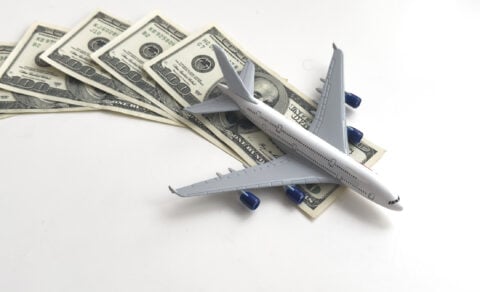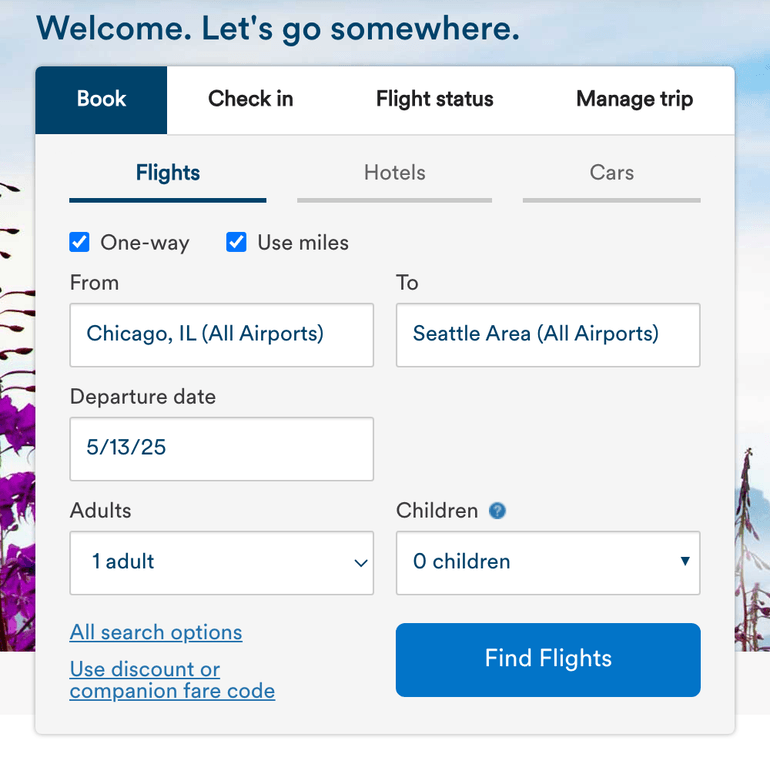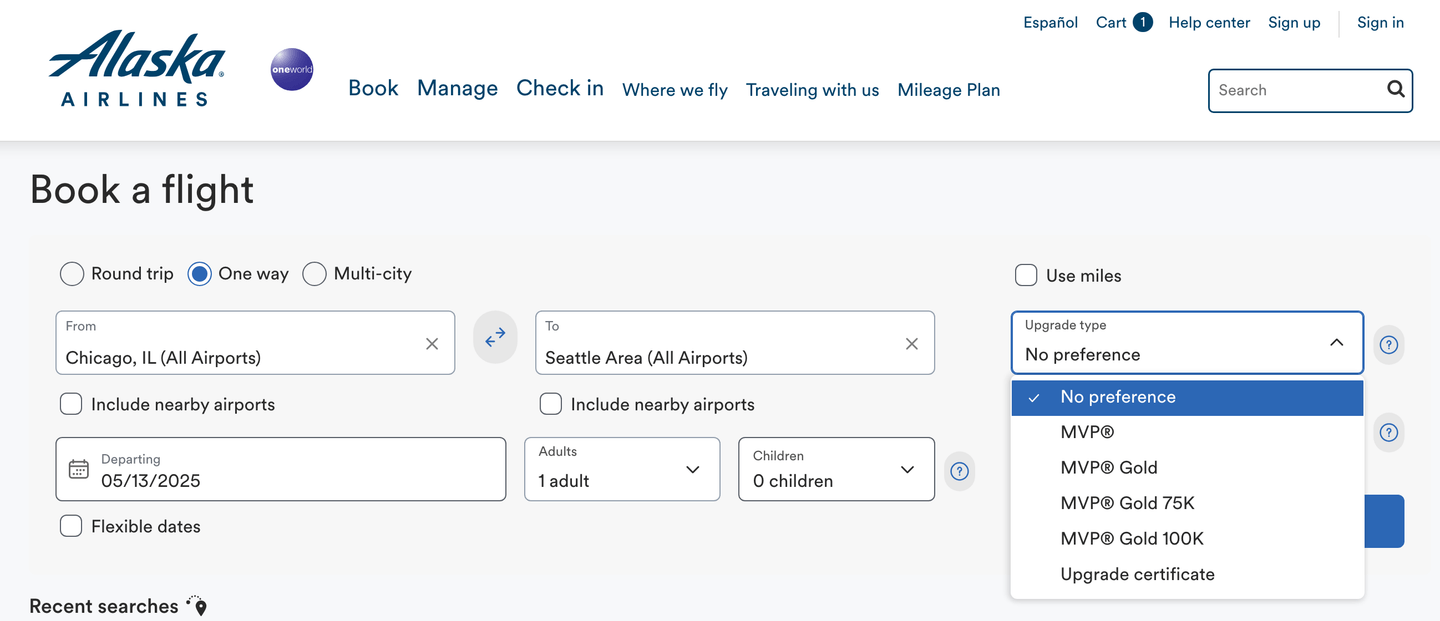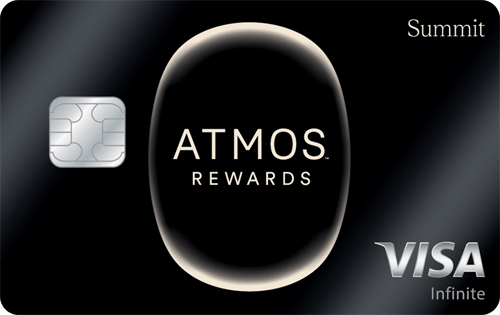The Complete Guide to Atmos Rewards Benefits and Elite Status
Atmos Rewards elite status perks are ultra-valuable, with Titanium delivering the most value to frequent flyers.

Many or all of the products on this page are from partners who compensate us when you click to or take an action on their website, but this does not influence our evaluations or ratings. Our opinions are our own.
If you're a frequent flyer on Alaska Airlines and Hawaiian Airlines, holding elite status through Atmos Rewards, the carriers' joint loyalty program, can be hugely rewarding.
In this guide, we break down how to earn Atmos elite status, the benefits and value you’ll get from the four elite levels, milestone rewards and details on upgrading to first class.
If you don't want to work towards elite status but still want some elite-like perks, an Atmos or Hawaiian co-branded credit card might be for you ( jump to learn more ).
On this page
What is Atmos elite status on Alaska and Hawaiian?
Atmos Rewards members can earn elite status by flying on Alaska, Hawaiian and their partners, through status matching or spending with an Atmos credit card and Atmos' non-air partners, including Lyft. There are four elite status levels: Silver, Gold, Platinum and Titanium (more details below).
🤓 Nerdy Tip
The loyalty tiers were rebranded August 2025, when Alaska and Hawaiian launched Atmos Rewards. If you're familiar with the old Mileage Plan tiers, you can think of Silver as MVP, Gold as MVP Gold, Platinum as MVP Gold 75K and Titanium as MVP Gold 100K. You keep your status for the remainder of the year in which you earn it, as well as the following calendar year and the January after. For example, if you reach Atmos Gold status in mid-2025, you’ll enjoy the benefits of that status through January 2027.
Your status is determined by the number of status points you earn each calendar year. Keep in mind that status points are solely used to determine your elite status; they are different from Atmos points, which you can redeem for award flights.
» Learn more: Do Alaska credit cards come with elite status?
You can even keep your status indefinitely by becoming a Million Miler. The requirement (you guessed it) is flying 1 million miles on Alaska- and Hawaiian-operated flights. That will earn you lifetime Atmos Gold status. If your goal is lifetime Atmos Platinum status, 2 million miles will get you there.
Million Milers get additional perks like four upgrade certificates per year, a complimentary food item in the main cabin when available, a 20,0000 status point boost each year, and the ability to share your lifetime or earned status with someone in your household.
Get the 'Cheat Codes' to Cheaper Travel
Unlocking the secret to saving a ton on travel is easier than you think. 📤 Our free newsletter shows you how in 5 min. or less.

Atmos Rewards elite benefits
Atmos Rewards elite benefits increase as you go up in status levels. Alaska offers four levels of elite status:
- Silver.
- Gold.
- Platinum.
- Titanium.
Each level provides bonus frequent flyer miles (so you'll earn Atmos points faster than everyone else), as well as tons of other benefits like the opportunity for upgrades to premium and first class and free checked bags.
Baggage fees start at $35 for your first bag, so that alone could be a huge, money-saving benefit (and it's available even to the folks with the lowest level of elite status). Plus, it can be way more relevant for folks who don't really care about other perks like dedicated phone lines or early boarding.
As you rise in the ranks of Atmos elites, your benefits get increasingly better. Here’s the full breakdown:
| Benefits | Silver | Gold | Platinum | Titanium |
|---|---|---|---|---|
| Mileage bonus | 25%. | 50%. | 100%. | 150%. |
| First class upgrade on Alaska at booking, when available, for flights within North America (+1 companion) | Y or B fares. | Y, B, H or K fares. | Y, B, H, K or M fares. | Y, B, H, K or M fares. |
| First and business class upgrades for all global flights (+1 companion), starting spring 2026 | No. | No. | No. | Yes. |
| First class upgrades on Hawaiian within North America, starting spring 2026 (+1 companion) | Yes. | Yes. | Yes. | Yes. |
| Extra Comfort upgrade on Hawaiian at time of booking, when available (excluding Main Cabin Basic) | No, only at check-in. | Y, W or Q fares (+1 companion). | All eligible fares (+1 companion). | All eligible fares (+1 companion). |
| Premium class upgrade on Alaska at booking, when available, for all global flights (+1 companion) | Y, B or H fares. | Y, B, H, K, M, L, V, S or N fares. | All fares except Saver. | All fares except Saver. |
| Saver fare upgrades on Alaska to premium or first class within two hours of departure | Yes. | Yes. | Yes. | Yes. |
| Oneworld reciprocal status | Ruby. | Sapphire. | Emerald. | Emerald. |
| Free checked bags (for member and companions) | 2 in 2025; 1 in 2026. | 2. | 3. | 3. |
| Other flight perks | • Priority check-in and boarding. • Dedicated phone lines for reservations and customer service. • Express security line at select airports. • Free preferred seating. | Silver benefits, plus: • Free same-day standby and waitlist for full flights. • Free same-day flight changes on Alaska. • Free premium drink or chocolate in Main Cabin on Alaska. | Gold benefits. | Platinum benefits, plus: • Free meal in Main Cabin on Alaska. • Choice benefit. |
Mileage bonus: Atmos elite members earn extra frequent flyer miles for flying. For example, if you have Atmos Platinum status and receive a 100% mileage bonus, you’ll earn a total of 2,000 miles for a 1,000-mile-long flight. Note that this bonus only applies to miles flown, not those earned through credit cards or other means. Additionally, the bonus does not apply to status points (see below).
The benefits listed apply to flights on Alaska Airlines and Hawaiian Airlines, unless otherwise noted. You can get similar benefits on partner airlines, but the details vary. Check the Atmos Rewards website for more information.
Benefits when flying on American Airlines
Atmos Rewards has a close partnership with American Airlines, offering reciprocal benefits for elite status holders. Atmos elites can select extra legroom economy seats on American Airlines flights within 24 hours of departure, while Gold and above can do so at time of booking.
Atmos elites are also eligible for complimentary upgrades on flights marketed and operated by Alaska or American when flying within the U.S. and between the U.S. and Canada, Mexico, the Bahamas, the Caribbean, Bermuda and Central America. If you're Gold or above, a companion can also be upgraded.
Titanium choice benefit
Those who reach Atmos Titanium elite status are able to select one of six options for their choice benefit:
- 50,000 bonus miles: NerdWallet values 50,000 Atmos points at $600.
- Complimentary Alaska Lounge+ membership: Retail cost of $795.
- Gifting Gold status: NerdWallet values Gold status at $1,740.
- Unlimited Wi-Fi sessions: At $8 per Wi-Fi session, you would have to use it more than 75 times a year to surpass $600 in value. (Alaska will be rolling out Starlink Wi-Fi, free to Atmos members, starting in 2026.)
- Four upgrade certificates: Usable for yourself and others, even if not traveling together.
- 75,000 point voucher toward an Atmos Rewards Unlocked experience: Bid for or purchase unique experiences using points.
Milestone rewards
In 2024, Alaska introduced perks for reaching certain milestones, similar to American Airlines' Loyalty Point Rewards program. That was retained in the Atmos Rewards program, and milestones are built around the status-point qualifying thresholds, which are:
- Silver: 20,000 points.
- Gold: 40,000 points.
- Platinum: 75,000 points.
- Titanium: 100,000 points.
Additional milestone perks can help encourage customers to fly more with Alaska or Hawaiian, even if they might not reach the next level of status. Plus, for Titanium members, it can incentivize further flying after reaching the top-tier status.
All Atmos members can select a reward from a list of options when they reach these milestones: 10K, 30K, 55K, 85K, 150K, 200K and 250K. Because the first perk threshold is 10,000 status points, that means you can earn a milestone reward even if you don't fly enough to qualify for elite status.
Milestone reward options
10,000 status points
One choice of:
- 750 bonus points.
- Pre-order a complimentary meal for your flight.
- A complimentary Wi-Fi pass.
- Complimentary Silver status for one trip.
- Earn double points with non-air partners.
- Upgrade an Avis/Budget rental.
- Contribute $10 toward sustainable aviation fuel.
30,000 status points
One choice of:
- 2,500 bonus points.
- $25 off a future flight.
- Four complimentary Wi-Fi passes.
- Complimentary Gold status for one trip.
- $100 off an Alaska lounge membership.
- Contribute $25 toward sustainable aviation fuel.
55,000 status points
Two choices from:
- 5,000 bonus points.
- 10,000 point voucher toward an Atmos Rewards Unlocked experience.
- Gift Silver status for one trip.
- A complimentary Alaska Lounge day pass.
- Two upgrade certificates.
- Contribute $50 toward sustainable aviation fuel.
85,000 status points
Two choices from:
- 15,000 bonus points.
- 25,000 point voucher toward an Atmos Rewards Unlocked experience.
- Two complimentary Alaska Lounge day passes.
- Two upgrade certificates.
- Gift Gold status for one trip.
- Gift Silver status.
- Roll over 10,000 status points for the following elite-qualifying year.
- Contribute $150 toward sustainable aviation fuel.
150,000 status points, and all subsequent milestones
Two one-time choices from:
- 15,000 bonus points.
- 25,000 points off an Atmos Rewards Unlocked experience.
- Two complimentary Alaska Lounge day passes.
- Two upgrade certificates.
- Roll over 10,000 status points for the following elite-qualifying year.
- Contribute $50 toward sustainable aviation fuel.
Starting in 2026, the 85K milestone will be awarded when you reach the 95K threshold. Also, the Titanium choice benefit will instead become a milestone perk awarded when you reach the 125K threshold.
How to get Atmos Rewards elite status
Atmos Rewards elite status is obtained by earning enough status points within a calendar year. It's also possible to match your status from another airline (see “status matching” below).
| Silver | Gold | Platinum | Titanium | |
|---|---|---|---|---|
| Earn this many status points | 20,000. | 40,000. | 75,000 (80,000 for 2026). | 100,000 (135,000 for 2026). |
Earn status points by flying
For 2025, status points can be earned by flying on Alaska and its qualifying partners. The number of status points you earn on a paid ticket is determined by the distance flown, whether you bought your ticket through Alaska or a partner airline, and the ticketed fare class.
Flights booked through Alaska will always earn status points equivalent to at least 100% of the distance flown, regardless of which airline you fly on. This includes Alaska and Hawaiian flights booked through Hawaiian. The one exception is if you purchase a Saver or basic fare, which will only earn 30%. You can get a bonus for more expensive fare classes and premium cabin fares.
However, partner flights booked on a partner website will earn at different rates: 25% of distance flown for discount economy, 50% for regular economy, 100% for premium economy, 125% for business class and 150% for first class. Those rates already factor in any premium bonuses (although premium cabins will earn more starting sometime in 2026).
While it may sound great to earn 150% for first class partner flights, contrast that to the 350% earnings you would get if you booked an international first class partner flight via Alaska. If your goal is to earn more miles, make sure to check prices via Alaska and partner sites to make sure you're getting the best return.
Other ways to earn status points
You can also earn status points by flying on award tickets. All award trips on Alaska, Hawaiian or its partners booked using Atmos points will earn status points based on the distance flown. There are no additional bonuses for booking an award flight in a premium cabin.
If you have an Atmos credit card, you can earn one status point for every $3 or $2 you spend on qualifying purchases, depending on which card you hold. That means it's theoretically possible to spend your way to top-tier status without ever setting foot on a plane. Remember: Status points are different from award points, so the amount of status points you receive from credit card spending will be much lower than the number of award points.
Another way to earn status points is by earning award points through spending with Alaska's non-airline partners, including Lyft. Those who link their Atmos and Lyft accounts can earn 2 points per $1 spent on everyday Lyft rides and 3 points per $1 spent on airport and elevated rides. For every 3,000 points earned, you'll earn 1,000 status points.
2026 changes to the Atmos program
Starting in 2026, Atmos Rewards is introducing new ways to earn status and points. Instead of awarding them solely based on distance flown, you'll need to choose whether you want to earn points based on distance flown, money spent on airfare and upgrades, or segments flown. Keep in mind that you won't be able to pick and choose how you want to earn for each flight; that selection can be changed once a year.
- Distance-based earning will continue as is, with 1 point for each mile flown. Award travelers will earn 1 status point for each mile flown. Class of service bonuses and minimum miles will not apply to this earning method.
- Spend-based earning will award 5 points per $1 spent on airfare, excluding taxes and fees. Paid upgrades to premium cabins will also earn at this rate. Award travelers will receive 1 status point per 20 points redeemed.
- Segment-based earning will award a flat 500 points per segment flown. Award travelers will get 500 status points per segment flown.
More details will be shared in 2026, but it can help to start thinking ahead about which method suits your travel habits. Those going for distance will benefit if they travel far on cheaper fares, while spend-based travelers will et the most value if they purchase pricy tickets, such as premium cabins or last-minute flights. If you're a road warrior (or often on flights within California, Alaska or Hawaii), you might prefer the segment-based system.
Once choice earn launches in 2026, passengers who select the spend-based method will benefit from higher bonuses when booking business and first class flights directly with partner airlines. Domestic premium cabin tickets will earn at 150%, and international premium cabin tickets will earn at 250%.
For 2026, status at the highest tiers will also be harder to earn. Platinum elites will need to earn 5,000 more status points than before, while Titaniums will need to earn 35,000 more. However, those who earn Platinum or Titanium in 2025 will have some reprieve. Atmos is offering a 5,000 status point boost for Platinums and a 20,000 status point boost for Titaniums, which will be deposited in February 2026.
First class Alaska flight upgrades
One of the most compelling — and confusing — benefits of Atmos elite status is the opportunity to receive Alaska flight upgrades from the main cabin to first class.
There are three ways to leverage your elite status to get yourself in front of the curtain:
- Instantly upgrade to first class by purchasing an appropriate “First Upgrade” ticket.
- Join the waiting list for complimentary upgrades.
- Use an upgrade certificate.
1. Buy an appropriate 'First Upgrade' ticket
Each flight has a certain number of “First Upgrade” fares available. As an Alaska elite, you can buy these fares directly at a (usually) lower price than the asking price for first class. You have to use the Alaska search tool.
To see these fares, select the “all search options” below the flight search tool on the Alaska homepage.

Then select the “Upgrade Type” dropdown and select your personal elite status level.

You’ll be presented with a search result that looks like this:

Note the blue icon with the corresponding "First Class upgrade available" text in the first result. As it states, the fare is available for an immediate upgrade. The yellow icon with clock hands, seen in the second result, means you'll be put on the waitlist. In general, you’ll only want to select the available blue fares.
However, be smart: In this example, the "First Upgrade" fare is actually more expensive than the regular first class fare. That's because Alaska is selling you a an upgrade-eligible economy fare, which are typically the most expensive. If first class is fairly empty, cheaper first class fares can be less expensive than the priciest economy fares.
These upgrades do not apply to companions on the same itinerary who do not have the same MVP status.
Note that elite status holders flying Alaska’s basic economy Saver fares are now eligible for upgrades to premium or first class two hours prior to departure.
» Learn more: How to maximize the Alaska Airlines Visa Business card
2. Join the waitlist for complimentary upgrades
If you don’t want to shell out extra for an instant upgrade, you can always roll the dice and hope for a complimentary one. If you have elite status with Alaska, you’ll automatically qualify for a complimentary upgrade, unless you opt out.

Whether you score a free upgrade depends on a number of factors. Alaska prioritizes upgrades in the following order:
- Elite status level.
- Million Miler status.
- Atmos™ Rewards Summit Visa Infinite® credit card holders.
- Corporate travelers.
- Status points earned in current year and prior year.
- Time of booking.
Complimentary upgrades begin clearing 120 hours prior to departure for Platinum and Titanium members, though the upgrade waitlist is only viewable 24 hours prior to departure.
Overwhelmed? Don’t worry — Alaska will handle everything after you opt in for the upgrade.
» Learn more: How Alaska upgrades work
3. Use an upgrade certificate
Starting at 55,000 status points, you can select upgrade certificates for reaching certain status point thresholds. These upgrade certificates can be used to upgrade your own travel, as well as anyone else flying on Alaska.
The upgrades can be applied to any paid Alaska flight with first-class availability, except tickets in the Q, O, G, or X fare classes. Award tickets are not eligible.
You can use an upgrade certificate during booking by using the "upgrade type" filter and selecting "upgrade certificate" to search for first class upgrade options. Look for the blue icon that indicates upgrade availability, and apply your certificate on that flight. (You won't be able to use the certificate to add yourself to the upgrade waitlist.)
Using the same search as earlier, we can see that the "First Upgrade" fare is cheaper. That makes sense because upgrade certificates give you the ability to upgrade your flight on cheaper economy fare classes.

If upgrade space opens after booking, you can choose to apply the certificate by going to your existing reservation.
🤓 Nerdy Tip
If you're an Atmos Rewards member eligible for complimentary upgrades, you will need to contact Alaska's reservations team and request to be removed from the upgrade waitlist. You must do that before you can apply an upgrade certificate to your existing reservation. » Learn more: The best airline credit cards
Alaska’s premium class at the front of the main cabin offers extra legroom and perks such as a free alcoholic drinks. Cash upgrades start at $15 per leg and vary based on the length of the flight. Atmos elite flyers are eligible for free upgrades. The process for premium-class upgrades is similar to first class, with a few differences.
Some fares are eligible for instant upgrades, depending on your Atmos level. When searching on the Alaska tool, enter your elite level in the “upgrade type” field. The price of a premium-class fare will appear in a separate column (see the screenshot from the first example above).
Similar to first-class upgrades, main cabin fares are eligible for complimentary upgrades based on availability and your elite level. Keep in mind that Saver fares are now eligible for premium-class upgrades two hours prior to departure based on availability and elite level.
Elite benefits on Alaska’s airline partners
Alaska’s airline partners offer a good way to earn status points, especially when flying internationally. Alaska is a member of Oneworld, so customers receive reciprocal benefits when flying on airlines within that alliance. (Hawaiian is not yet a Oneworld member, but it's set to join in 2026.)
Earning on partners
Before you book an around-the-world flight hoping to score Platinum status, remember that whether you book your flight through Alaska or through its partners will impact the amount of status points you earn. All economy fares on partner airlines will earn 100% of distance flown when booked through Alaska; however, it will only earn 25% to 50% when booked via a partner's website.
Partner and Oneworld benefits
Due to Alaska's membership in Oneworld, Atmos elites receive reciprocal Oneworld status, which offers benefits when flying on those airlines.
- Atmos Silver elites receive Oneworld Ruby status. This offers some seat selection benefits when flying with Oneworld airlines.
- Atmos Gold elites receive Oneworld Sapphire status. This offers seat selection benefits, business class lounge access on international itineraries, priority boarding and baggage allowance when flying with Oneworld airlines.
- Atmos Platinum and Titanium elites receive Oneworld Emerald status. This offers seat selection benefits, first and business-class lounge access on international itineraries, priority boarding, expedited security and baggage allowance when flying with Oneworld airlines.
In addition to those Oneworld benefits, some of Alaska’s partners separately extend lounge access to Gold, Platinum and Titanium members when flying through their hubs. Those partners include:
- Icelandair (Keflavik).
- Hainan Airlines (multiple airports in mainland China).
» Learn more: How do Alaska's hotel partners work?
Atmos status match
Atmos offers a status match challenge if you already have status with a select set of North American airlines. You will have 90 days to meet the requirements of the challenge; once you do so, your status will be extended further.
To see which Atmos level you qualify for based on your current airline elite status, check this status match page. On that page, you can submit a screenshot of your current status membership page. The status that you're matching from cannot be complimentary or earned through a promotion.
You can only status match once for the lifetime of your account, so use this opportunity wisely.
Another way to maximize the status match is by applying in the second half of the year. If you apply after July and complete the challenge, your status will extend to the end of the next calendar year. However, if you apply before the end of June and complete the challenge, your status is only good for the rest of the calendar year.
Here are the status match challenge requirements:
- Extend Silver status by earning 5,000 base points.
- Extend Gold status by earning 10,000 base points.
- Extend Platinum status by earning 20,000 base points.
Only flights owned and operated by Alaska or Hawaiian will count toward the challenge.
Atmos credit card benefits
Alaska's new Atmos™ Rewards Summit Visa Infinite® credit card, which has an annual fee of $395, is the best card to hold if you're chasing elite status.
This card gets you 10,000 status points on every account anniversary, and an additional 1 status point for every $2 spent on purchases with the card. That anniversary bonus alone gets you halfway to Silver status. The 10,000 status point deposit is also enough to qualify you for the first milestone reward in the Atmos Rewards program — even before you step foot on a plane.
The Atmos™ Rewards Ascent Visa Signature® credit card and the Atmos™ Rewards Visa Signature® Business card also get you 1 status point for every $3 spent on purchases, up to 30,000 status points.
Come January 1, 2026, there will be no limit to how many status points you can earn this way.
How to maximize your rewards
You want a travel credit card that prioritizes what’s important to you. Here are some of the best travel credit cards of 2025:
- Flexibility, point transfers and a large bonus: Chase Sapphire Preferred® Card
- No annual fee: Wells Fargo Autograph® Card
- Flat-rate travel rewards: Capital One Venture Rewards Credit Card
- Bonus travel rewards and high-end perks: Chase Sapphire Reserve®
- Luxury perks: American Express Platinum Card®
- Business travelers: Ink Business Preferred® Credit Card
Article sources
NerdWallet writers are subject matter authorities who use primary,
trustworthy sources to inform their work, including peer-reviewed
studies, government websites, academic research and interviews with
industry experts. All content is fact-checked for accuracy, timeliness
and relevance. You can learn more about NerdWallet's high
standards for journalism by reading our
editorial guidelines.
More like this
Related articles









